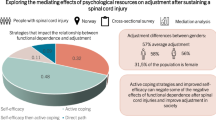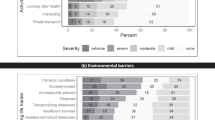Abstract
Study design:
Qualitative study.
Objective:
To determine categories of coping the first year after injury used by 24 young adults who sustained a spinal cord injury (SCI) during adolescence (11–15 years).
Setting:
Sweden.
Methods:
Content analysis using the existing theories of coping as a framework, including the instrument BriefCOPE—a deductive category application. The analysis looked critically at comments in the interviews that reflected attempts to cope with the injury during the first post-injury year.
Results:
All 14 of the categories of coping described by the BriefCOPE were included in the interviews at least once, except ‘self-blame’, which was not used by any interviewee. In addition to the predefined categories of the BriefCOPE, three new coping categories emerged from the interviews: fighting spirit, downward comparison and helping others.
Conclusions:
Adolescents who sustain SCIs use a variety of strategies to help them to cope with the consequences of the injury. Many of these coping strategies are similar to those used by others facing stresses, but it is instructive to hear, in their own words, how young adults recall the coping strategies they used as adolescents when they were injured and also how they conceptualized the process of coping. This information can be useful in helping future patients.
Sponsorship:
The study was supported by the Promobilia foundation and the Norrbacka–Eugenia foundation.
Similar content being viewed by others
Log in or create a free account to read this content
Gain free access to this article, as well as selected content from this journal and more on nature.com
or
References
Chevalier Z, Kennedy P, Sherlock O . Spinal cord injury, coping and psychological adjustment: a literature review. Spinal Cord 2009; 47: 778–782.
Lazarus R, Folkman S . Stress Appraisal and Coping. Springer Publishing: New York, NY, 1984, p 445.
Lazarus R, Launier R (eds). Stress-Related Transactions Between Person And Environment. Plenum: New York, 1978, p 327.
Lazarus RS, Folkman S . Coping and adaptation. In: WD G (ed.). The Handbook of Behavioral Medicine. Guilford: New York, 1984, p 282–325.
Kennedy P, Evans MJ, Berry C, Mullin J . A longitudinal analysis of psychological impact and coping strategies following spinal cord injury. Br J Health Psychol 2000; 5: 157–172.
Frydenberg E . Coping competencies: what to teach and when. Theor Pract 2004; 43: 14–22.
Pollard C, Kennedy P . A longitudinal analysis of emotional impact, coping strategies and post-traumatic psychological growth following spinal cord injury: a 10 year review. Brit J Health Psychol 2007; 12: 347–362.
Frydenberg E (ed.). Adolescent Coping Advances in Theory Research and Practice, 2nd edn. Oxford, Routledge, 2008, p 337.
Seiffge-Krenke I . Coping With Chronic Illness in Adolescence: An Overview of Research From the Past 25 Years. Cambridge University Press: New York, 2001.
Anderson CJ, Vogel LC, Chlan KM, Betz RR . Coping with spinal cord injury: strategies used by adults who sustained their injuries as children or adolescents. J Spinal Cord Med 2008; 31: 290–296.
Chlan KM, Zebracki K, Vogel LC . Spirituality and life satisfaction in adults with pediatric-onset spinal cord injury. Spinal Cord 2011; 49: 371–375.
Carver CS . You want to measure coping but your protocol's too long: consider the brief COPE. Int J Behav Med 1997; 4: 92–100.
Augutis M, Levi R, Asplund K, Berg-Kelly K . Psychosocial aspects of traumatic spinal cord injury with onset during adolescence: a qualitative study. J Spinal Cord Med 2007; 30 (Suppl 1): S55–S64.
Patton Q . Qualitative Evaluation and Research Methods, 2nd edn. Sage Publication: Newbury Park, California, 1990, p 530.
Mayring P . Qualitative Content Analysis 2000 [cited May 2011]. Available from: http://www.qualitative-research.net/fqs-texte/2-00/2-00mayring-e.htm.
Mayring P . Qualitative Inhaltsanalyse Grundlagen und Techniken, 7th edn. Deutscher Studien Verlag: (In German)Weinheim, 2000, p 117.
Augutis M, Levi R . Pediatric spinal cord injury in Sweden: incidence, etiology and outcome. Spinal Cord 2003; 41: 328–336.
Augutis M, Malker H, Levi R . Pediatric spinal cord injury in Sweden; how to identify a cohort of rare events. Spinal Cord 2003; 41: 337–346.
WHO (World Health Organization). 10 Facts on Adolescent Health 2008. [cited August 2011]. Available from: http://www.who.int/features/factfiles/adolescent_health/en/index.html.
Folkman S, Lazarus RS, Dunkel-Schetter C, DeLongis A, Gruen RJ . Dynamics of a stressful encounter: cognitive appraisal, coping, and encounter outcomes. J Pers Soc Psychol 1986; 50: 992–1003.
Frydenberg E . Understanding coping: social support as a major resource. In: Frydenberg E (editor). Learning to Cope: Developing as a Person in Complex Societies. Oxford University Press: Oxford UK, 1998, p 15–16.
Taylor SE, Stanton AL . Coping resources, coping processes, and mental health. Annu Rev Clin Psychol 2007; 3: 377–401.
Elfstrom ML, Ryden A, Kreuter M, Persson LO, Sullivan M . Linkages between coping and psychological outcome in the spinal cord lesioned: development of SCL-related measures. Spinal Cord 2002; 40: 23–29.
Carpenter C . The experience of spinal cord injury: the individual's perspective--implications for rehabilitation practice. Phys Ther 1994; 74: 614–628 discussion 28–29.
Kerstin W, Gabriele B, Richard L . What promotes physical activity after spinal cord injury? An interview study from a patient perspective. Disabil Rehabil 2006; 28: 481–488.
Standal OF, Jespersen E . Peers as resources for learning: a situated learning approach to adapted physical activity in rehabilitation. Adapt Phys Act Q 2008; 25: 208–227.
Buunk AP, Zurriaga R, Gonzalez P . Social comparison, coping and depression in people with spinal cord injury. Psychol Health 2006; 21: 791–807.
Buunk AP, Zurriaga R, Gonzalez P, Terol C, Roig SL . Targets and dimensions of social comparison among people with spinal cord injury and other health problems. Brit J Health Psych 2006; 11 (Pt 4): 677–693.
Derlega VJ, Greene K, Henson JM, Winstead BA . Social comparison activity in coping with HIV. Int J STD AIDS 2008; 19: 164–167.
Hooper H, Ryan S, Hassell A . The role of social comparison in coping with rheumatoid arthritis: an interview study. Musculoskeletal Care 2004; 2: 195–206.
Chung MC, Preveza E, Papandreou K, Prevezas N . Spinal cord injury, posttraumatic stress, and locus of control among the elderly: a comparison with young and middle-aged patients. Psychiatry 2006; 69: 69–80.
Kennedy P, Evans M, Sandhu N . Psychological adjustment to spinal cord injury: the contribution of coping, hope and cognitive appraisals. Psychol Health Med 2009; 14: 17–33.
Hagevi M . Religion och Politik (In Swedish). Malmö: Liber, 2005, p 239.
Frydenberg E, Lewis R . Adolescents least able to cope: how do they respond to their stresses? Br J Guid Couns 2004; 32: 25–37.
Acknowledgements
We are grateful to associate professor Karl-Gustaf Norbergh, MidSweden University, for his help with the data validation. The study was supported by the Promobilia Foundation and the Norrbacka–Eugenia foundation.
Author information
Authors and Affiliations
Corresponding author
Ethics declarations
Competing interests
The authors declare no conflict of interest.
Rights and permissions
About this article
Cite this article
Augutis, M., Anderson, C. Coping strategies recalled by young adults who sustained a spinal cord injury during adolescence. Spinal Cord 50, 213–219 (2012). https://doi.org/10.1038/sc.2011.137
Received:
Revised:
Accepted:
Published:
Issue date:
DOI: https://doi.org/10.1038/sc.2011.137



